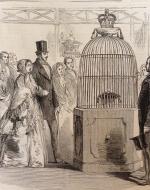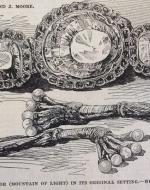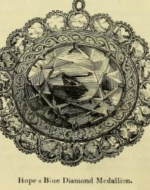Created by Anastasia Rogozinski on Sun, 02/09/2025 - 17:53
Description:
The Great Exhibition of 1851 was an extravagent showcase of industry, art, and innovation that captured the world's attention. Among its most dazzling displays were the precious jewels that sparkled and captivated audiences. Precious jewels are emblematic of the Victorian era's fascination with riches and discovery. Queen Victoria and Prince Albert visited frequently, particularly to see the Koh-i-Noor diamond, which was thought to be, at the time, the largest and most valuable diamond in the world. The diamond was also a popular attraction for the general public, emphasizing the interest in luxury. Given that jewels were displayed from countries all over the world, people entertained thoughts of the exotic. These treasures served as physical symbols of Britain's expanding global influence, which reflects the nation's ambitions during a period of change and progress. The Koh-i-Noor and other precious jewels are still popular attractions today. The Koh-i-Noor is part of the Crown Jewels and on display at the Tower of London. Their value and grandeur is still marveled over today, which shows their long-lasting effect on the general population.
Booth for Precious Jewels at our Great Exhibition of 1851, designed by Anastasia Rogozinski, 2025. This display highlights the variety of precious jewels that were displayed at the Great Exhibition of 1851. There were gems, stones, and jewelry shown at the Great Exhibition from many different countries, such as England, Russia, India, and Spain. To create my display, I found an image illustrating part of the Great Exhibition and used it as my background. Then, I created little exhibits to show the different precious jewels that I found in my research.
"The Koh-i-Noor on display at the Great Exhibition Prior to its Re-installation," Illustrated London News, 1851. Victoria and Albert Museum, London. The Koh-i-Noor, thought to be the largest precious jewel at the time, was on display during the Great Exhibition. Before this, the diamond was given to Queen Victoria by the East India Company after Duleep Singh, the ten-year-old Maharaja, gave the diamond up through the Treaty of Lahore (1849). The name Koh-i-Noor translates to "Mountain of Light," which is fitting since the diamond was around 105.6 carats at the time of the Great Exhibition. The image illustrates the diamond as it was originally displayed on a red cushion and protected by the security of the birdcage-like contraption. This creation was considered to be very modern and to have expert security. The crown at the top of the cage emphasizes that this was an item of great significance and the property of Queen Victoria and Prince Albert.
"The Koh-i-Noor, between two other diamonds, as it was originally presented to Queen Victoria," Illustrated London News, 1851, Victoria and Albert Museum, London. This image illustrates the Koh-i-Noor diamond in its original setting. It is the center diamond with two other jewels on the sides. This is how the diamond was displayed under the iron cage, previously pictured. The diamond would later be taken out of this setting and arranged differently to better catch audience's attention as they were relatively unimpressed with this original display. The Great Exibition Catalogue (1851) discusses the history of the diamond before it was given to Queen Victoria. Mention of the diamond has appeared historically and in legends. Consequently, according to the Hindu legend, the Koh-i-Noor diamond was found around 3001 B.C. in South Indian mines. We do not know for sure the complete history of the Koh-i-Noor diamond except that it traveled around and belonged to Indian people and royalty until it was forcibly given to British royalty, Queen Victoria at the time.
Bourne, J. C., Cole, H., Davies, J. P., Delamotte, P. H., Ellis, R., Jackson, M., Jarvis, J., Nichols, C. P., Petermann, A., & Tenniel, J. (1851). Official Descriptive and Illustrated Catalogue. Spicer Brothers, Wholesale Stationers : W. Clowes and Sons, Printers.
"Hope & Blue Diamond Medallion," 1851, Henry Thomas Hope, in The Official Descriptive Catalogue of the Great Exhibition of the Works of Industry of all Nations, Class 23, "Works in Precious Metals, Jewellery" (volume 2), p. 682. Henry Thomas Hope was the proprietor and showcased the Blue Diamond during the Great Exhibition. This image shows that the diamond itself was mounted into a medallion, surrounded by many smaller diamonds and intricate metalwork. This mounting helped to increase its appearance of grandeur and value. As a result of its large size and rare color, the Blue Diamond was considered very unique at the time. In fact, the Great Exhibition Catalogues explain that the diamond contains carbon. A diamond that is "perfectly pure" will not have any color, but the blue color in this diamond comes from "the prescence of some foreign substance." The diamond was said to weigh approximately 177 grains or 57 carats. Similar to the Koh-i-Noor diamond, it is believed that the Hope Diamond was originally found in an Indian mine before eventually making its way to England and displayed during the Great Exhibition.
"Brilliants and Rubies," 1851, Bolin & Ian, in The Official Descriptive Catalogue of the Great Exhibition of the Works of Industry of all Nations, Jewellery, "Russia" (volume 3), p. 628. England was not the only country at the Great Exhibition showing off their wealth and success through precious jewels. Russia also displayed jewels at the Great Exhibition. This drawing illustrates a set created by Bolin & Ian in St. Petersburg, Russia. The piece itself is made up of a diadem, which contains diamonds and other precious stones, a brooch in the shape of a branch, a bracelet made up of diamonds and turquoise jewels, an additional gold chain bracelet with diamonds and pearls, and a bracelet with a vine leaf made of diamonds and grapes made of rubies. This lucious display of diamonds, pearls, rubies, and other precious jewels highlights the detailed craftsmanship and riches from Russia at this time. In London, there were places of great wealth, emphasized by the Great Exhibition itself, and places of great poverty. This disparity also occurred in Russia, but it would not have been prevalent in their displays to the world at the Great Exhibition.






